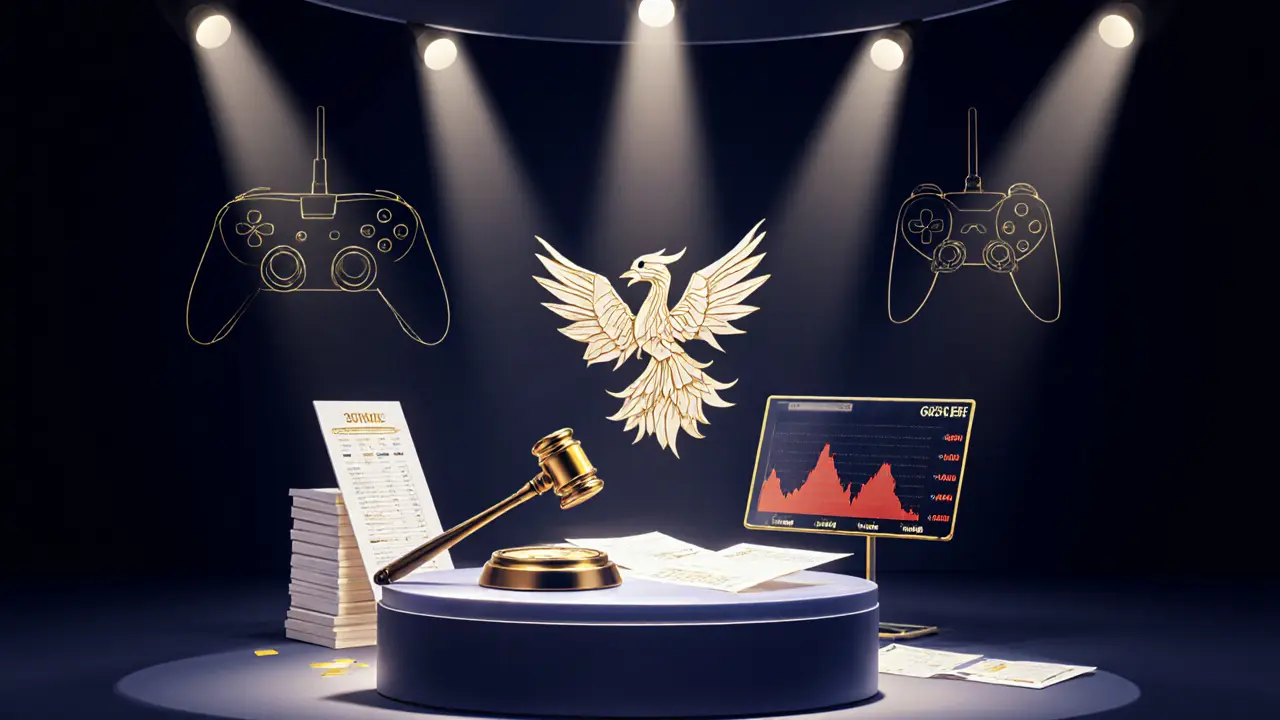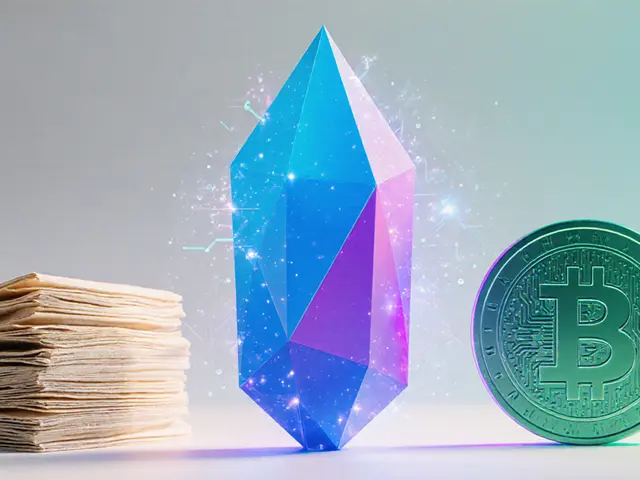NFT Value Calculator
Digital Scarcity
How rare the NFT is in the collection
Creator Reputation
Establishment level of the creator
Utility & Functionality
Additional benefits beyond visual appeal
Market Demand & Liquidity
Activity and trading volume
Community Engagement
Vibrancy of the NFT community
Estimated Value
Based on your inputs, your NFT's estimated value is:
$0
(This is an illustrative calculation)
Factors Used:
Quick Takeaways
- Value comes from digital scarcity, creator reputation, utility, market demand, and liquidity.
- Floor price is the lowest listed price in a collection and acts as a market benchmark.
- Technical costs like gas fees and ETH volatility can swing the asking price.
- Utility‑centric NFTs (virtual land, event access) often fetch higher premiums.
- Use a checklist - rarity, community, trading volume, and on‑chain fees - to evaluate any NFT.
How NFTs Work: The Basics
At its core, an NFT lives on a blockchain - most commonly Ethereum the leading smart‑contract platform that supports ERC‑721 and ERC‑1155 token standards. The token’s metadata points to a digital file (art, video, 3D model) and a smart contract that enforces uniqueness. Because the ledger is immutable, anyone can verify ownership without a central authority, which creates a transparent provenance chain that collectors love.
Core Value Drivers
Think of NFT pricing as a multi‑factor equation. Each driver contributes a piece of the puzzle, and the strongest drivers differ by project.
1. Digital Scarcity
Scarcity is the easiest way to spark demand. Creators decide how many copies to mint - from a single "1 of 1" masterpiece to a series of 10,000 items. Fewer copies mean higher perceived rarity, which usually translates to a higher price floor. The rarity isn’t just about quantity; it also includes unique attribute combinations (e.g., a specific background color or trait). Rarity tiers create a price hierarchy within the same collection.
2. Creator Reputation
Established artists or influencers bring a built‑in collector base. An NFT from a well‑known Beeple can sell for millions because the name alone assures buyers of artistic merit and future resale potential. Reputation also covers prior auction performance and crossover success in traditional art markets.
3. Utility & Functionality
Beyond visual appeal, many NFTs unlock real‑world benefits. Virtual real‑estate parcels in the Metaverse generate rental income, while access‑based tokens grant entry to exclusive events, Discord channels, or future drops. These utility layers add a cash‑flow component, often justifying a price premium of 20‑30% over comparable pure‑collectibles.
4. Market Demand & Liquidity
High trading volume and deep liquidity pools signal an active market. Research from ETHZurich shows that collections with steady daily volume tend to maintain stable floor prices, while volatile, low‑volume projects experience sharp price swings. When many buyers and sellers are constantly swapping, price discovery becomes more reliable.
5. Community & Social Proof
A vibrant community on Discord, Twitter, or Telegram acts as a network effect. Projects that host regular AMAs, giveaways, and collaborator drop‑ins keep collectors engaged, which translates into higher floors. Celebrity endorsements can create a short‑term FOMO spike, but sustained community activity is what keeps the floor from collapsing.
Floor Price Mechanics
The floor price the lowest listed price of an NFT within a specific collection on secondary markets is the easiest entry point for new buyers. It’s a live metric that updates every time a seller lists a lower price. A rising floor often indicates growing confidence, while a dropping floor warns of waning interest. For example, if the "CryptoPunks" floor climbs from 80ETH to 95ETH over a month, the collection is likely seeing renewed collector demand.

Pricing Models and Auction Formats
Creators choose how to list their tokens:
- Fixed‑price listings: Set a price; buyers can instantly purchase. Ideal for utility NFTs where predictable access matters.
- English auction: Bids rise until time expires. Generates competitive pressure and often pushes prices above the floor.
- Dutch auction: Price starts high and drops over time, letting impatient buyers snag a deal.
- Reserve price: Minimum acceptable price; if bids don’t meet it, the sale is void.
Most platforms also embed royalty clauses - typically 5‑10% of every secondary sale goes back to the creator. These royalties influence initial pricing because they signal ongoing creator earnings, which can make the NFT feel like an investment rather than a one‑off purchase.
Technical Factors That Nudge Prices
Even if an NFT looks perfect, on‑chain realities matter:
- Gas fees: High network congestion on Ethereum can add $20‑$100 to a transaction, prompting sellers to raise listing prices to cover the cost.
- Blockchain congestion: During busy periods (e.g., major NFT drops), latency rises and some buyers wait for cheaper off‑peak windows.
- ETH/USD volatility: Since most NFTs are priced in ETH, a 10% swing in ETH/USD can instantly alter the USD value of a listed token.
- Smart‑contract features: ERC‑1155 contracts that batch multiple tokens can lower minting costs, while ERC‑721 contracts with royalty logic may command higher initial prices.
Evaluating an NFT: A Practical Checklist
| Factor | What to Look For | Impact on Price |
|---|---|---|
| Scarcity | Total supply, rarity traits, edition size | Higher rarity → higher premium |
| Creator Reputation | Previous sales, follower count, art credentials | Established names boost baseline price |
| Utility | Access rights, income streams, interoperability | Utility adds 20‑30% price lift |
| Liquidity | Daily trade volume, number of active buyers | High liquidity stabilizes price, reduces discount |
| Community Health | Discord activity, Twitter engagement, AMA frequency | Active communities support floor growth |
| Technical Costs | Current gas fees, ETH volatility | Higher costs may inflate listings |
Use the table as a quick reference before you bid. If an NFT scores well on most rows, you’re likely looking at a solid investment.
Future Value Propositions
Beyond art, NFTs are entering new domains that promise fresh pricing models:
- Gaming: In‑game items tokenized as NFTs can be sold on secondary markets, creating earn‑as‑you‑play economies.
- Digital Identity: NFT‑backed passports or credentials could become valuable as verification tools.
- DAO Membership: Owning a DAO‑gate NFT grants voting rights and profit shares, turning the token into a governance stake.
- AR/VR Integration: As augmented reality headsets mature, NFTs that overlay digital assets onto the physical world may command premium prices for immersive experiences.
Regulatory clarity and institutional adoption are also shaping price stability. When banks start offering NFT custody services, the perceived risk drops, which can lead to more conservative, long‑term pricing structures.
TL;DR (for the impatient)
- Value = scarcity + creator reputation + utility + demand + liquidity.
- Floor price = market’s lowest entry point; watch its trend.
- Technical costs (gas, ETH swings) can add 5‑15% to any listing.
- Utility NFTs (virtual land, access passes) often sell 20‑30% higher.
- Use the checklist table to vet any NFT before buying.

Frequently Asked Questions
What makes an NFT valuable?
Value comes from a mix of digital scarcity, the creator’s reputation, any built‑in utility (like access or income), market demand, and how liquid the collection is on secondary markets.
How do I read a floor price?
The floor price is the cheapest listed token in a collection at any given moment. A rising floor signals buyer confidence, while a falling floor warns of waning interest.
Do gas fees affect NFT prices?
Yes. High Ethereum gas fees add a real cost to each purchase, so sellers often bump the listed price to cover that expense.
Are utility NFTs worth more than pure art NFTs?
Generally, utility adds a premium of 20‑30% because buyers get extra benefits, like virtual land income or exclusive event access, on top of ownership.
What should I avoid when pricing an NFT?
Don’t rely solely on hype or celebrity retweets. Verify the collection’s liquidity, check the rarity attributes, and factor in gas fees before setting or accepting a price.





John E Owren
This is one of the clearest breakdowns of NFT valuation I've seen in a while. The checklist alone is worth saving. I've used this exact framework when advising friends who are new to the space. No fluff, just actionable metrics.
Joseph Eckelkamp
Ah, yes-the sacred trinity of NFT pricing: scarcity, reputation, and utility… as if these weren't just rebranded versions of classic collectibles with extra steps. You know what’s ironic? The same people who scoff at Beanie Babies now pay $200,000 for a JPEG of a monkey with a hat. The blockchain doesn’t make it art-it just makes the transaction harder to reverse.
Dimitri Breiner
I appreciate how you tied liquidity to price stability-it’s often overlooked. I’ve seen so many people buy into hyped collections only to realize there’s zero trading volume a week later. Always check the 7-day volume chart before you commit. It’s not sexy, but it’s the difference between holding and hemorrhaging.
LeAnn Dolly-Powell
This is so helpful! 🙌 I’ve been trying to understand NFTs for months and this finally clicked. The utility part especially-like getting access to real events-makes it feel less like gambling and more like owning a ticket to something bigger. Thank you for writing this!
William Burns
The notion that digital scarcity confers value is a metaphysical fallacy. A tokenized image, regardless of its blockchain provenance, remains a replication of pixels. The so-called 'utility' is often a hollow promise-virtual land in Decentraland is not land. It is an illusion maintained by collective delusion and speculative capital. One must ask: what is the intrinsic value of a hyperlink to a JPEG?
Ashley Cecil
While your analysis is methodical, it fails to address the ethical implications of perpetuating speculative markets under the guise of innovation. The environmental cost of Ethereum’s proof-of-work past, the predatory marketing to uninformed buyers, and the normalization of wealth signaling through digital artifacts-these are not neutral factors. They are systemic harms masked as progress.
Jennifer Rosada
I'm glad you mentioned gas fees-but you barely scratched the surface. Did you know that during the 2021 NFT boom, some collectors paid over $300 in gas just to mint a single token? And then they cried when the floor dropped? That’s not market dynamics-that’s financial masochism. The real risk isn't the NFT; it's the people who think they're buying art and not paying for a lottery ticket.
Rohit Sreenath
You think you know value? The truth is, no one owns anything. The blockchain is just a ledger. The real owners are the ones who control the servers. You think you have your NFT? No. You have a promise. And promises can be deleted.
Sam Kessler
Let’s be honest-this entire ecosystem is a front for hedge funds to dump their trash assets onto retail investors. The ‘community’ is a botnet. The ‘utility’ is a Terms of Service clause. The ‘floor price’ is manipulated by wash trading. And the creators? They cash out on day one and disappear. This isn’t innovation. It’s a pyramid scheme with better graphics.
Anastasia Alamanou
I want to add a layer to the utility discussion: interoperability. NFTs that can be used across multiple metaverses or gaming ecosystems have exponentially higher long-term value. Right now, most are siloed-but the future belongs to tokens that function as digital passports, not just profile pictures. Keep an eye on projects building with open standards like ERC-6551. That’s where the real innovation is happening.
adam pop
They’re tracking your wallet. Every time you buy, sell, or even look at an NFT, they’re logging it. The government, the banks, the crypto firms-they’re building a permanent digital footprint of your taste, your wealth, your habits. This isn’t ownership. It’s surveillance with a blockchain sticker on it.
John E Owren
I’ve been following your comments here, and I appreciate your perspective. You’re right to emphasize liquidity-it’s the quiet hero of this space. I’ve walked away from three collections this year because the volume dropped below 10 ETH/day. It’s not glamorous, but it’s the only thing keeping me from losing everything.